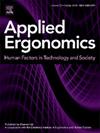Exploring the usability and perceived benefits and barriers of portable lift assist devices among paramedic workers
IF 3.4
2区 工程技术
Q2 ENGINEERING, INDUSTRIAL
引用次数: 0
Abstract
Patient lifting can expose health care workers to musculoskeletal disorder (MSD) risk factors. Portable lift assist devices may reduce exposure during lifting, however limited evidence on user feedback and efficacy is available to inform purchase decisions. Therefore, we tested the efficacy of two portable lift assist devices relative to a manual lift when lifting an individual from the floor. Participants lifted an actor from the floor using a manual technique and by using two lift assist devices, either an inflatable bladder or a mechanical device. Ratings of perceived exertion demonstrated that the lift assist devices decreased or maintained perceived exertion relative to the manual lift. Semi-structured interviews provided context where perceived benefits of the devices (i.e., decreased exertion and MSD risk) outweighed barriers (i.e., added time to call). The results of this study can inform stakeholders making decisions about lift assist devices purchases.
探索可用性和感知的好处和障碍的便携式升降辅助设备在医护人员。
病人举重可以暴露卫生保健工作者肌肉骨骼疾病(MSD)的危险因素。便携式升降辅助装置可以减少在升降过程中的暴露,但是,关于用户反馈和功效的证据有限,无法为购买决策提供信息。因此,我们测试了两种便携式升降机辅助装置相对于手动升降机在将人从地板上抬起时的功效。参与者使用手动技术和两个升降辅助装置(充气气囊或机械装置)将演员从地板上抬起。感知力的评分表明,相对于手动提升,提升辅助装置减少或保持了感知力。半结构化访谈提供了设备的感知好处(即减少体力消耗和MSD风险)超过障碍(即增加通话时间)的背景。这项研究的结果可以为利益相关者提供有关电梯辅助设备购买的信息。
本文章由计算机程序翻译,如有差异,请以英文原文为准。
求助全文
约1分钟内获得全文
求助全文
来源期刊

Applied Ergonomics
工程技术-工程:工业
CiteScore
7.50
自引率
9.40%
发文量
248
审稿时长
53 days
期刊介绍:
Applied Ergonomics is aimed at ergonomists and all those interested in applying ergonomics/human factors in the design, planning and management of technical and social systems at work or leisure. Readership is truly international with subscribers in over 50 countries. Professionals for whom Applied Ergonomics is of interest include: ergonomists, designers, industrial engineers, health and safety specialists, systems engineers, design engineers, organizational psychologists, occupational health specialists and human-computer interaction specialists.
 求助内容:
求助内容: 应助结果提醒方式:
应助结果提醒方式:


